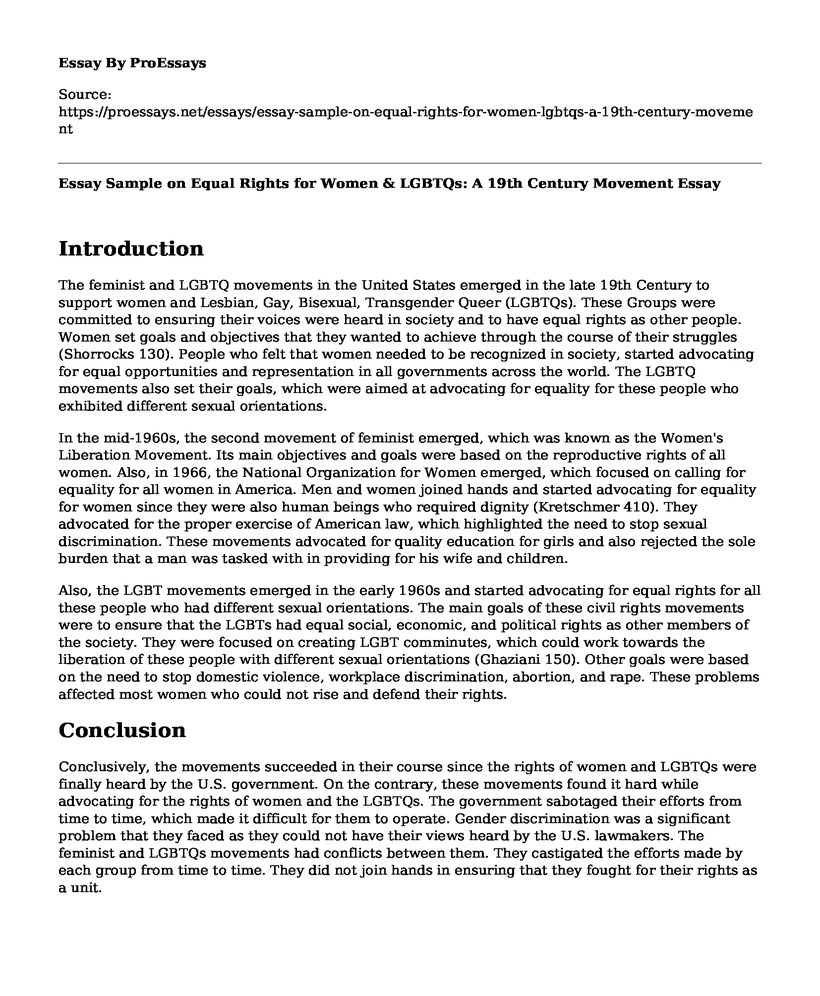Introduction
The feminist and LGBTQ movements in the United States emerged in the late 19th Century to support women and Lesbian, Gay, Bisexual, Transgender Queer (LGBTQs). These Groups were committed to ensuring their voices were heard in society and to have equal rights as other people. Women set goals and objectives that they wanted to achieve through the course of their struggles (Shorrocks 130). People who felt that women needed to be recognized in society, started advocating for equal opportunities and representation in all governments across the world. The LGBTQ movements also set their goals, which were aimed at advocating for equality for these people who exhibited different sexual orientations.
In the mid-1960s, the second movement of feminist emerged, which was known as the Women's Liberation Movement. Its main objectives and goals were based on the reproductive rights of all women. Also, in 1966, the National Organization for Women emerged, which focused on calling for equality for all women in America. Men and women joined hands and started advocating for equality for women since they were also human beings who required dignity (Kretschmer 410). They advocated for the proper exercise of American law, which highlighted the need to stop sexual discrimination. These movements advocated for quality education for girls and also rejected the sole burden that a man was tasked with in providing for his wife and children.
Also, the LGBT movements emerged in the early 1960s and started advocating for equal rights for all these people who had different sexual orientations. The main goals of these civil rights movements were to ensure that the LGBTs had equal social, economic, and political rights as other members of the society. They were focused on creating LGBT comminutes, which could work towards the liberation of these people with different sexual orientations (Ghaziani 150). Other goals were based on the need to stop domestic violence, workplace discrimination, abortion, and rape. These problems affected most women who could not rise and defend their rights.
Conclusion
Conclusively, the movements succeeded in their course since the rights of women and LGBTQs were finally heard by the U.S. government. On the contrary, these movements found it hard while advocating for the rights of women and the LGBTQs. The government sabotaged their efforts from time to time, which made it difficult for them to operate. Gender discrimination was a significant problem that they faced as they could not have their views heard by the U.S. lawmakers. The feminist and LGBTQs movements had conflicts between them. They castigated the efforts made by each group from time to time. They did not join hands in ensuring that they fought for their rights as a unit.
Works Cited
Ghaziani, Amin, Verta Taylor, and Amy Stone. "Cycles of sameness and difference in LGBT social movements." Annual Review of Sociology 42 (2016): 165-183.
Kretschmer, Kelsy. "Should We Stay or Should We Go? Local and National Factionalism in the National Organization for Women." Qualitative Sociology 40.4 (2017): 403-423.
Shorrocks, Rosalind. "A feminist generation? Cohort change in gender-role attitudes and the second-wave feminist movement." International Journal of Public Opinion Research 30.1 (2016): 125-145.
Cite this page
Essay Sample on Equal Rights for Women & LGBTQs: A 19th Century Movement. (2023, Mar 12). Retrieved from https://proessays.net/essays/essay-sample-on-equal-rights-for-women-lgbtqs-a-19th-century-movement
If you are the original author of this essay and no longer wish to have it published on the ProEssays website, please click below to request its removal:
- Sociology Essay Example: Aboriginal People in Canada
- Why Orca Whales Should Not Live in Captivity Essay
- Essay on Crash: Racial Injustices, Socioeconomic Status, and Human Interaction
- Women's Independence: A Sociological Contemplation - Essay Sample
- Essay Sample on Media Manipulation: Distorting News and Beliefs
- Essay Example on Women in Agriculture: A Growing Concern
- Sex Offender Registration: Averting Sexual Violence or Recidivism - Report Example







